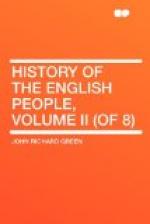[Sidenote: Rising of Bruce]
With the conquest and settlement of Scotland the glory of Edward seemed again complete. The bitterness of his humiliation at home indeed still preyed upon him, and in measure after measure we see his purpose of renewing the strife with the baronage. In 1303 he found a means of evading his pledge to levy no new taxes on merchandise save by assent of the realm in a consent of the foreign merchants, whether procured by royal pressure or no, to purchase by stated payments certain privileges of trading. In this “New Custom” lay the origin of our import duties. A formal absolution from his promises which he obtained from Pope Clement the Fifth in 1305 showed that he looked on his triumph in the North as enabling him to reopen the questions which he had yielded. But again Scotland stayed his hand. Only four months had passed since its submission, and he was preparing for a joint Parliament of the two nations at Carlisle, when the conquered country suddenly sprang again to arms. Its new leader was Robert Bruce, a grandson of one of the original claimants of the crown. The Norman house of Bruce formed a part of the Yorkshire baronage, but it had acquired through intermarriages the Earldom of Carrick and the Lordship of Annandale. Both the claimant and his son had been pretty steadily on the English side in the contest with Balliol and Wallace, and Robert had himself been trained in the English court and stood high in the king’s favour. But the withdrawal of Balliol gave a new force to his claims upon the crown, and the discovery of an intrigue which he had set on foot with the Bishop of St. Andrews so roused Edward’s jealousy that Bruce fled for his life across the border. Early in 1306 he met Comyn, the Lord of Badenoch, to whose treachery he attributed the disclosure of his plans, in the church of the Grey Friars at Dumfries, and after the interchange of a few hot words struck him with his dagger to the ground. It was an outrage that admitted of no forgiveness, and Bruce for very safety was forced to assume the crown six weeks after in the Abbey of Scone. The news roused Scotland again to arms, and summoned Edward to a fresh contest with his unconquerable foe. But the murder of Comyn had changed the king’s mood to a terrible pitilessness. He threatened death against all concerned in the outrage, and exposed the Countess




